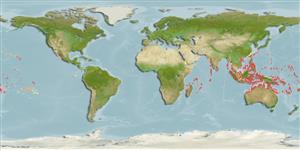Common names from other countries
>
Holocentriformes (Squirrelfishes, soldierfishes) >
Holocentridae (Squirrelfishes, soldierfishes) > Myripristinae
Etymology: Myripristis: Greek, myros, -ou = male of morey eel + Greek, pristis = saw (Ref. 45335).
More on author: Bleeker.
Environment: milieu / climate zone / depth range / distribution range
Ecologia
marino associati a barriera corallina; distribuzione batimetrica 1 - 30 m (Ref. 9710). Tropical; 30°N - 23°S
Indo-Pacific: East Africa south to Natal, South Africa and east to the Line, Society, and Tuamoto islands, north to the Ryukyu Islands, south to the Great Barrier Reef. It has not been reported from the Red Sea, Gulf of Aden, Oman, or the Persian Gulf and is absent in the Hawaiian Islands, Marquesas, Pitcairn Group, and Easter Island (Ref. 12419).
Size / Peso / Age
Maturity: Lm ? range ? - ? cm
Max length : 35.0 cm TL maschio/sesso non determinato; (Ref. 30573); common length : 25.0 cm TL maschio/sesso non determinato; (Ref. 6113)
Spine dorsali (totale) : 11; Raggi dorsali molli (totale) : 14 - 16; Spine anali: 4; Raggi anali molli: 12 - 14. Pale salmon pink; edges of scales dorsally on body deep blue to black; median fins with broad black outer border. Inner pectoral fin axil naked except for one (rarely two) moderate scales on lower half (Ref. 2334).
Usually inhabits coral-rich areas of drop-offs and steep channel slopes from below the effects of surge to over 25 m. Occurs singly or in small groups, sometimes with other species (Ref. 9710, 48635). A nocturnal species hiding in caves or beneath ledges by day, feeds on plankton such as crab larvae at night. Maximum depth reported taken from Ref. 128797.
Life cycle and mating behavior
Maturities | Riproduzione | Spawnings | Egg(s) | Fecundities | Larve
Randall, J.E. and D.W. Greenfield, 1996. Revision of the Indo-Pacific holocentrid fishes of the genus Myripristis, with descriptions of three new species. Indo-Pac. Fish. (25):61 p. (Ref. 12419)
IUCN Red List Status (Ref. 130435)
CITES (Ref. 128078)
Not Evaluated
Threat to humans
Harmless
Human uses
Pesca: scarso interesse commerciale
Strumenti
Special reports
Download XML
Fonti Internet
Estimates based on models
Preferred temperature (Ref.
115969): 25.3 - 29.3, mean 28.5 (based on 2956 cells).
Phylogenetic diversity index (Ref.
82804): PD
50 = 0.5000 [Uniqueness, from 0.5 = low to 2.0 = high].
Bayesian length-weight: a=0.02089 (0.01313 - 0.03326), b=3.01 (2.88 - 3.14), in cm Total Length, based on LWR estimates for this species & Genus-body shape (Ref.
93245).
Trophic level (Ref.
69278): 3.4 ±0.45 se; based on food items.
Resilienza (Ref.
120179): Alto, tempo minimo di raddoppiamento della popolazione meno di 15 mesi (Preliminary K or Fecundity.).
Fishing Vulnerability (Ref.
59153): Low vulnerability (25 of 100).
